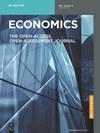“客观”贝叶斯单位根检验的威力
IF 0.8
4区 经济学
Q3 ECONOMICS
Economics-The Open Access Open-Assessment E-Journal
Pub Date : 2009-11-05
DOI:10.2174/1874919400902010071
引用次数: 13
摘要
一些研究人员,例如Koop(1992)和Sims(1988),主张使用贝叶斯替代单位根检验,而不是使用增强的Dickey-Fuller检验(ADF)的经典方法。本文研究了Koop(1992)所称的单位根检验的“客观”贝叶斯方法的力量。Koop的“客观”贝叶斯检验很有趣,因为Phillips (1991a,1991b)呼吁对时间序列进行更客观的贝叶斯分析。我们将“客观的”贝叶斯单位根检验应用于后布雷顿森林时代的长期购买力平价(PPP)研究和蒙特卡罗模拟。总的来说,我们的结果表明,“客观”贝叶斯检验偏向于趋势平稳性。我们的结论是,至少对于“客观”贝叶斯检验,它并不比经典的ADF方法在单位根检验中更好,并且由于其偏差,Koop建议的“客观”先验是不合适的。我要感谢Stephen M. Miller教授,南方经济协会年会的与会者,以及康涅狄格大学经济系的“棕色袋子”研讨会对本文早期草稿的评论。剩下的错误由我负责。本文章由计算机程序翻译,如有差异,请以英文原文为准。
The Power of the "Objective" Bayesian Unit-Root Test
Abstract Some researchers, for example, Koop (1992), and Sims (1988), advocated forBayesian alternatives to unit-root testing over the classical approach using theaugmented Dickey-Fuller test (ADF). This paper studies the power of what Koop(1992) has called the ”Objective” Bayesian approach to unit-root testing. Koop’s”objective” Bayesian test is interesting in light of the call by Phillips (1991a,1991b) for more objective Bayesian analysis of time series. We apply the ”ob-jective” Bayesian unit-root test to a study of long-run purchasing power parity(PPP) in the post-Bretton Woods era and also Monte Carlo simulations. Overall,our results suggest that the ”objective” Bayesian test is biased in favor of trend-stationarity. We conclude that, at least for the ”objective” Bayesian test, it is notbetter than the classical ADF approach in unit-root tests, and because of its bias,the ”objective” priors suggested by Koop is not appropriate.Journal of Economic Literature Classification: C11, C22, F31I wish to thank Professor Stephen M. Miller, participants at the Southern Eco-nomic Association Annual Meetings, and Department of Economics, Universityof Connecticut, brown-bag seminar for comments on an earlier draft of this paper.Remaining errors are my sole responsibilities.
求助全文
通过发布文献求助,成功后即可免费获取论文全文。
去求助
来源期刊

Economics-The Open Access Open-Assessment E-Journal
Economics, Econometrics and Finance-Economics, Econometrics and Finance (all)
CiteScore
3.20
自引率
0.00%
发文量
15
审稿时长
30 weeks
 求助内容:
求助内容: 应助结果提醒方式:
应助结果提醒方式:


